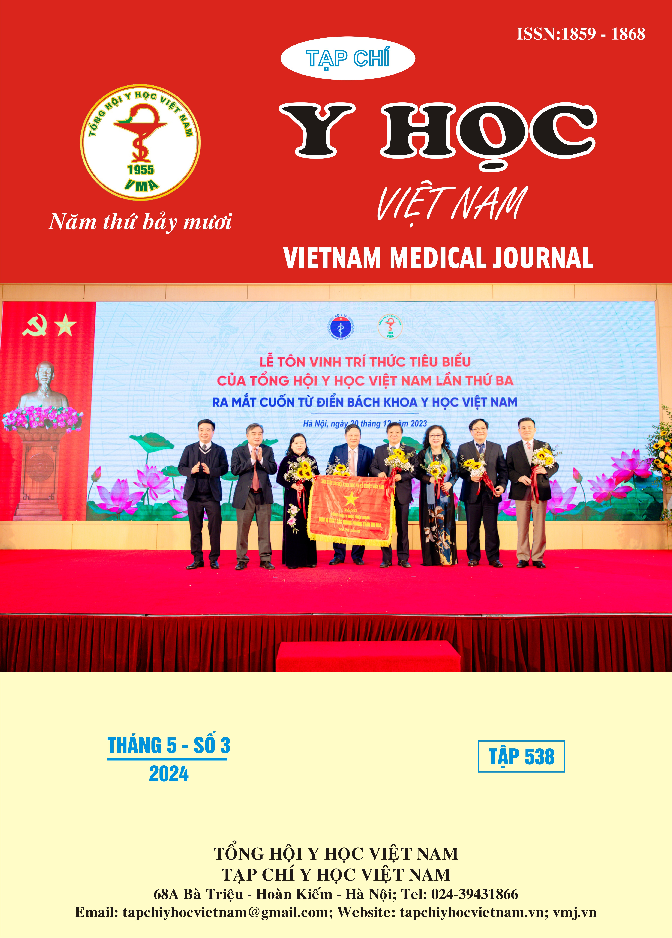CHARACTERISTICS OF KIDNEY SIZE, FUNCTION, AND DONOR SELECTION PERSPECTIVES IN KIDNEY TRANSPLANTATION FROM LIVING RELATED DONORS AT VIET DUC FRIENDSHIP HOSPITAL
Main Article Content
Abstract
Objective: Evaluate the characteristics of kidney size on MSCT (Multi-Slice Computed Tomography), renal function on scintigraphy with 99mTcDTPA, and the selection of donor kidneys, along with blood relations. Patients and methods: Descriptive study involving cross-sectional imaging of 84 healthy individuals with the same blood relation as the kidney recipients. After obtaining 24-hour creatinine clearance assessment, renal morphology was evaluated using MSCT 256 slices, and scintigraphy with 99mTcDTPA was performed from January 2018 to Decembre 2022. Results: The minimum age for kidney donation was 30 years, the maximum was 64 years, with a mean ± SD of 49.49 ± 7.44. Donors aged 41–60 comprised the majority, accounting for 82.15%. The male-to-female ratio among kidney donors was 25/59. In most cases, mothers volunteered to donate kidneys to their offspring, representing 54.76%. The rate of fathers donating to children (23.81%) and siblings donating to each other (21.43%) was relatively equal. The kidney size on MSCT 256 slices was as follows: Right kidney in males: 100.64 ± 7.58 mm, females: 100.05 ± 8.36 mm; Left kidney in males: 100.5 ± 11.03 mm, females: 103.00 ± 11.51 mm. The size of donated kidneys was 100.1 ± 7.79 mm, and the retained kidneys were 102.35 ± 8.89 mm. Renal function on scintigraphy with 99mTcDTPA showed an average glomerular filtration rate (GFR) in both genders of 113.26 ± 14.91 mL/minute. GFR for the right kidney was 55.73 ± 8.02 mL/minute, and for the left kidney, it was 57.53 ± 7.78 mL/minute. The donor kidney function percentage was 48.43 ± 1.92%, and the retained kidney function percentage was 51.57 ± 1.92%. No correlation was found between GFR on scintigraphy and estimated formula. Conclusion: Kidney size on CT scans and functional imaging play a significant role in the selection of kidney donors. The decision to donate a kidney is personalized based on various factors.
Article Details
Keywords
Kidney size, relate living kidney transplantation
References
2. Đỗ Tất Cường, Bùi Văn Mạnh, Lê Việt Thắng, Phạm Quốc Toản, Hoàng Trân Anh (2010), “Nhận xét về kết quả các trường hợp ghép thận tại bệnh viện 103”, Y học Việt Nam, 2: tr 306-310.
3. Patankar K, Low RST, Blakeway D, Ferrari P. Comparison of computer tomographic volumetry versus nuclear split renal function to determine residual renal function after living kidney
donation. Acta Radiol 2014;55:753e60.
4. Yokoyama N, Ishimura T (2015). Usefulness of three-dimensional computerized tomographic volumetry for determining split renal function in donors for living-related kidney transplantation. Transplant Proc ;47:588 -590.
5. Lal H, Singh A, Prasad R, et al (2021) Determination of split renal function in voluntary renal donors by multidetector computed tomography and nuclear renography: How well do they correlate? S Afr J Rad. ;25(1), https://doi.org/10.4102/sajr.v2
6. Fides RS, Brian IS, Regianld Lerebours (2020). Correlation of preoperative imaging characteristics with donor outcomes and operative difficulty in laparoscopic donor nephrectomy. Am J Transplant.;20:752–760
7. JY. Choi and O.J Kwo (2013). Is the Graft Function of Living Donor Renal Transplants Associated With Renal Mass Matching by Computed Tomography Angiographic Volumetry? Transplantation Proceedings, 45, 2919 -2924
8. Giral M, Foucher Y, Karam G, et al (2010). Kidney and recipient weight incompatibility reduces long-term graft survival. J Am Soc Nephrol21:1022
9. Nobuyuki Nakamura, Chikao Aoyagi, Hiroshi Matsuzaki, Ryusaburo Furuya (2015). Comparison of renal scintigraphy and computed tomographic renal volumetry for determining split renal function and estimating post-transplant renal function. Transplant Proc;47:2700 -2
10. Nguyễn Thị Ánh Hường (2008), Nghiên cứu phẫu thuật lấy thận ghép ở người sống cho thận, Luận án tiến sĩ y học, Học viện Quân y, Hà Nội.


